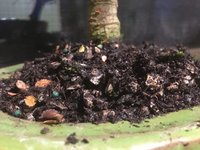CliffracerX
Yamadori
'Tis I again, emerging from my strange little corner of the Tiny Forest to pester y'all wonderful Nuts with some questions & pictures. I recently ordered a beautiful Chinese Elm (Ulmus Parvifolia, specifically) from Kawa No Oka Bonsai to finally fill in the Chinese Elm-shaped hole in my collection.

It arrived today looking gorgeous - even if my weather wasn't!

It's been a little stressed by the transit and lost a few leaves due to shipping, but otherwise is in pretty pristine condition - turgor is pretty high across the board, everything's nice & green, and the whole box had that wonderful smell of chlorophyll hard at work when I opened it. With that in mind, my question now is how best to care for it moving forwards, and to that end I'll be sharing what I've learned so far for y'all to try and take apart if I'm wrong about anything.

It arrived today looking gorgeous - even if my weather wasn't!

It's been a little stressed by the transit and lost a few leaves due to shipping, but otherwise is in pretty pristine condition - turgor is pretty high across the board, everything's nice & green, and the whole box had that wonderful smell of chlorophyll hard at work when I opened it. With that in mind, my question now is how best to care for it moving forwards, and to that end I'll be sharing what I've learned so far for y'all to try and take apart if I'm wrong about anything.
- Dormancy requirements: optional, but recommended once it's acclimated to my environment better.
- Per my conversations with Jason @ Kawa No Oka, it - and all their other elms - are usually given a dormancy period, but were woken up early this year to get that night, dense flush of spring growth.
- Additionally, per both the IBC and the wise words of our own nuttiest nut, due to the subtropical nature of Chinese Elms, they have no problems going without a dormancy period, and will instead have quiscence periods, similar to full-tropical trees like ficuses.
- Worst-case, if I really want it to go dormant but don't want to risk Mountain Weather(tm) zapping it with an unexpected plunge into negative-bajillion F temps, easing it in with some cool outdoors air in the fall & moving it into a mini-fridge is apparently viable.
- Light requirements: plenty, which I'll be providing with supplemental lighting when indoors.
- I have both a dedicated plant shelf for tropicals that's got tons of lighting, a decomissioned aerogarden, a surprisingly beefy USB grow light for desk plants, and a fancy lighting setup for an indoors lemon tree, and know my options enough to pick up extra if I need. When it's indoors - and awake (which may end up being a lot of the time, as my outdoors-thumb is browner than a mallsai juniper kept in a windowsill for a year) - it'll have plenty of supplemental lighting.
- Given the density of the canopy, tiny internodes, and well-reduced leaves, I take ensuring high-quality lighting extra seriously for it - it's clear a lot of work has gone into training and reduction, and I don't want a few weeks of crappy lighting to ruin that with Leggy Syndrome(tm).
- Watering requirements: fairly bog-standard water-when-dry.
- The one complication here is in the moss - I've heard conflicting advice on if it's better to remove moss or leave it on, especially for tropicals like this. If it presents no danger to the tree, and won't be too much a pain to care for, I'd likely leave it on 'till a repotting, as it does an incredible job working with the tree itself to sell the idea that this is a big ol' tree providing shade to a field.
- That said, if it's more advantageous to remove it for the tree's health, I'd likely try and strip it off & grow it separately so I'll have a nice supply of bonsai-ready moss for when I wanna put things on display.
- Other than that, AFAIK it's pretty standard, watering-wise; wait 'till the soil feels only lightly moist about an inch down, then water thoroughly. I'm guessing based on the minor loss in turgor on the new leaves due to shipping that it's also a fairly 'talkative' tree, and so if I'm not watering it enough it'll probably let me know by getting droopy and sad-looking, same as my Fukien Tea.
- Future plans: at this point, likely largely maintenance!
- Being that this is a fairly well-established and trained tree, I suspect it's mostly going to need maintenance work, moving forwards - pruning, cleaning up the branch structure a bit, and general work to keep things nicely reduced.
- I can't see the full state of the branch structure clearly due to the canopy at present, but I do suspect it might need a little work to clean up & improve density further.
- I'm also inevitably going to take some cuttings, which I understand to be incredibly easy - pretty much just trim a branch, stick it in the dirt, and forget about it for a year.



